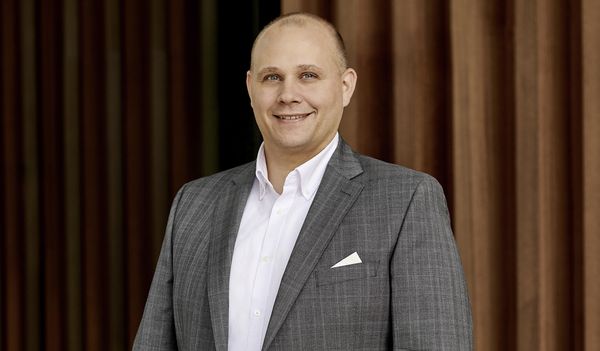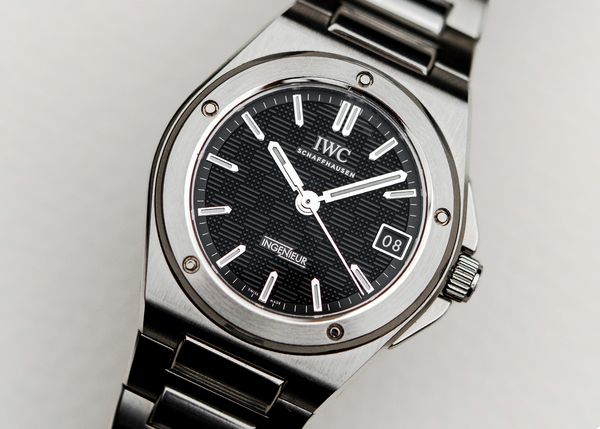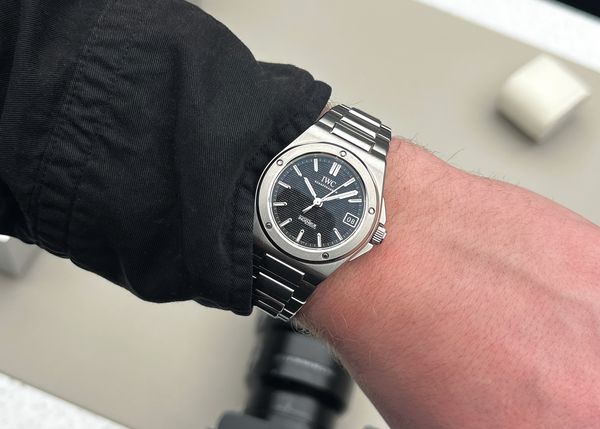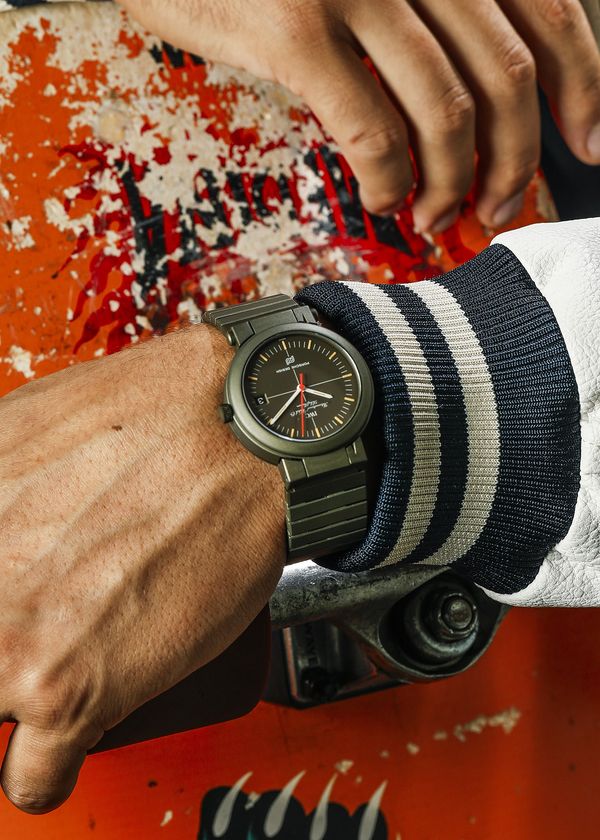– By Logan Baker
IWC is different from most other Swiss watch brands.
Founded in 1868 by an American and headquartered in the German-speaking town of Schaffhausen – far from the traditional watchmaking hubs of the Vallée de Joux and Geneva – the company has long followed its own path.
That independent streak remains intact today, even as IWC plays a central role in the world of contemporary mechanical watchmaking.
As the brand’s heritage has taken on greater importance – shaping product development and collector engagement – the role of those who preserve and interpret that legacy has become more visible and outward-facing. One such figure is Dr. David Seyffer, the longtime curator of the IWC Museum. He’s a trained historian with a deep knowledge of IWC’s archives and an obvious passion for the stories mechanical watches can tell.
We sat down with Dr. Seyffer during Watches and Wonders in Geneva this past April, just after IWC launched a new 35mm version of the Ingenieur. What followed was a wide-ranging conversation that touched on everything from pocket watches and the Mark 11 to the underrated charm of 1980s IWC – and why collectors today are finally starting to pay attention.
Logan Baker / PHILLIPS: I think we'd all love to hear about your background. Let's start from the beginning. How did you first become interested in watches, and IWC, specifically?
Dr. David Seyffer (DS), Museum Curator at IWC Schaffhausen: I grew up in the 1980s, when there was that one famous affordable watch everyone seemed to collect. Then, in the early '90s, I stumbled into the world of mechanical watchmaking completely by accident. The quartz battery in my watch had died, so my mother handed me an old square watch she had lying around. She told me it was automatic and would wind itself with motion. I didn't know what a mechanical watch was – but I quickly figured it out. That watch, by the way, was a Heuer Monaco. I had no clue at the time how important it was.
As for how I first came into contact with IWC, that goes back to the 1980s as well – specifically to the Da Vinci. If you were even casually interested in watches during that era, or even just window-shopping, it was the IWC Da Vinci Perpetual Calendar that was the icon. Later, when I started my career working in the heritage department at Mercedes-Benz in Stuttgart, I bought my first stainless steel luxury watch. I felt like I had made it. The sales agent at the boutique asked me, “What watch do you dream about?” I told him I wanted a perpetual calendar, the Da Vinci from IWC.
And what happened six years later? I started working at IWC. It had always been on my radar.
My academic background is in history – my training pointed me toward the late Roman Empire or early Middle Ages. But jobs in that field are rare. That’s why I shifted toward the history of technology. I began as a historian at Mercedes-Benz, and in 2007, I joined IWC Schaffhausen. I’ve been here ever since.
Were you always in the Museum Curator position?
DS: No, at first, I was only responsible for the archives. This was super interesting because it was still a bit of a "green" field. Of course, IWC had always taken care of its ledgers, where you could find the detailed history and numbers of every watch – but there were more things to discover.
At the time, there was no structure to these old records. With my experience working in the Mercedes-Benz corporate archive, I was able to provide a system for IWC's record-keeping. I also quickly realized: "Wow, IWC has so many treasures."
We're still learning more from the archival process. Sometimes I find new sources that are super interesting – including ones that were super helpful for this year's launch [of the Ingenieur Automatic 35].
For example, since 2023, we've received original meeting minutes from the 1970s that document the Ingenieur SL's design process, including Gérald Genta's involvement in it.
This is what makes my work really interesting – the stories are never complete.
What does your day-to-day look like? When you go into the office, what are you planning to do?
DS: It’s a day-to-day job in the sense that new questions come up all the time – and you always have to be ready to answer them. That’s where things get interesting, whether the questions come from inside the company, from collectors, or from the press. When it’s about a specific watch or someone’s background, I have to think carefully. You can’t give random answers. We need to be precise, and I have to see the bigger picture before responding.
Some days, everything I planned gets thrown out the window because of a single question. I might have set out to focus on one task, but suddenly there’s something new that needs attention. It can be challenging – but that’s also what keeps it exciting.
What I do is never boring. Sometimes, I'm focused on more strategic work, and sometimes, I'm focused solely on archiving. Maybe I need to make some quick fixes in the museum, or I have to respond to urgent questions from my colleagues in the press department. Every day is different.
You work with collectors frequently, right?
DS: Yes, although I wouldn't call it working together – it's really a partnership.
We have a huge archive with lots of information, but it's extremely helpful to also have the knowledge of the people who have been collecting IWCs for 40 or 50 years. It's amazing to have today's means of international communication. We can now connect and share information with individuals all over the world. It's really a partnership with the collectors. There are some projects that we work on together, such as writing books and creating exhibitions.
I think it's a win-win situation; ultimately, we're learning and confirming more detailed information about IWC together.
When you acquire pieces for the museum, how do you balance the tension between restoration and keeping them in their original condition?
DS: It's always a discussion, to be honest.
Most often, when you see a watch in the museum, you see it exactly as it is. Maybe it’s not shiny, but we want to show its character, its scars, and everything it’s been through. Take an early Ingenieur, for example: it has a soft iron dial, so of course there’s rust. That patina is part of what people come to see. We don’t alter it.
But if we’re displaying a vintage pocket watch in a silver case, we’ll usually polish it. If it’s too tarnished, visitors might not even recognize the material.
Are there any vintage references or collections that you think are underrated by collectors today, ones that people aren't paying attention to?
DS: I think the 1980s Ingenieur watches have been completely under the radar.
You have these really nice Ingenieur SL designs that were created by Genta and represented the next generation of the collection. I think they deserve a lot more attention. And with the launch of the latest Ingenieur at Watches and Wonders, we've shrunk the current model to 35 millimeters. It makes sense.
I'm really happy that people are starting to look more at the 1980s. It's the result of a new generation of collectors who are looking at the watches that were released when they were growing up. I think this is also why the IWC-Porsche Design watches are becoming more and more interesting to collectors. I think they've been a bit underrated for years.
Other watch companies have similar technical, engineering, and military backgrounds. What do you think draws collectors to IWC specifically?
DS: We try to be as transparent as possible when uncovering the history and background of our watches. The best example is the Mark 11 – we’re in regular contact with knowledgeable experts and collectors who’ve studied it in-depth. So there are no secrets. We want to tell the full story, together with the community. That’s what makes it compelling for collectors: they know we’ll help them get to the truth. Everyone wants the facts.
If you had an unlimited budget and access to any and every IWC watch ever made, what would your dream museum collection be?
DS: I think what we are always looking for are watches that really highlight IWC's history. A dream would be to display every movement ever made by IWC. It would underline what IWC is all about.
We did something similar a couple of years ago with the Big Pilot, but people forget about pocket watches. This is where we came from. If you look at how finely they were made, the quality, and how they run – there's so much horological value. It's a bit of a pity that collectors forget about this part of our history. So we need to educate a little more to showcase these beautiful movements and highlight how they were made.
You can learn more about David Seyffer and the IWC Museum online.
About Phillips In Association With Bacs & Russo
The team of specialists at PHILLIPS Watches is dedicated to an uncompromised approach to quality, transparency, and client service. Phillips in Association with Bacs & Russo holds the world record for the most successful watch auction, with its Geneva Watch Auction: XIV having realized $74.5 million in 2021. Over the course of 2021 and 2022, the company sold 100% of the watches offered, a first in the industry, resulting in the highest annual total in history across all the auction houses at $227 million.
About Logan Baker
Logan has spent the past ten years covering the watch industry from every angle. He joined Phillips in Association with Bacs & Russo in early 2023 as Senior Editorial Manager, after previous roles at Hodinkee and WatchTime. Originally from Texas, he spent a decade in New York and now calls Geneva home.
Recommended Reading
In-Depth: A Review of IWC's Pioneering Neo-Vintage Influence
The IWC Portugieser: The Anonymous Watch That Became World Famous
An IWC Fliegerchronograph Reference 3705 Linked To Günter Blümlein





